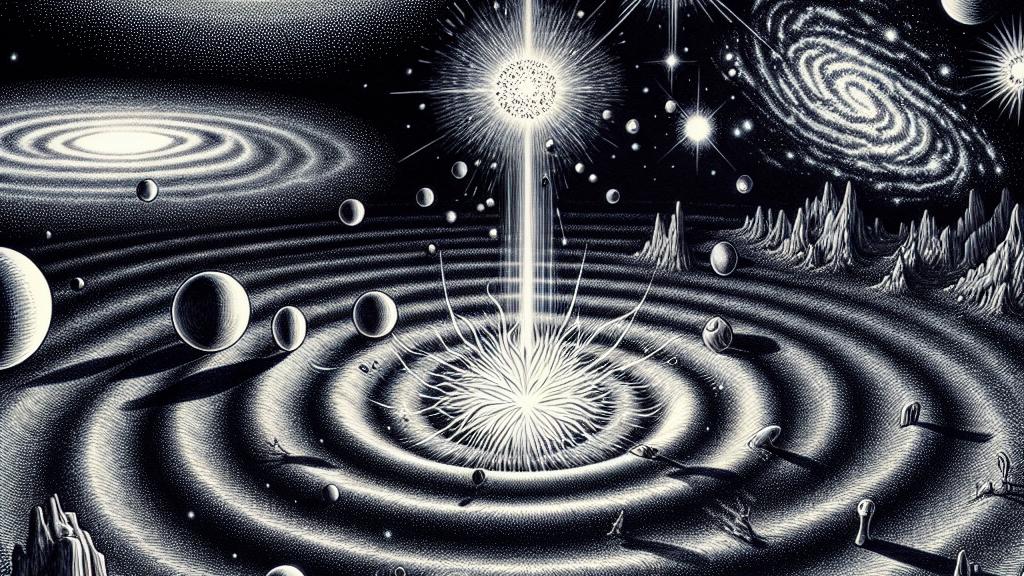Exploring Connections Between Gravitational Waves and Fast Radio Bursts
Overview
- Gravitational waves may hold the key to understanding the enigmatic fast radio bursts.
- Magnetars, especially SGR 1935+2154, are critical to this ongoing cosmic puzzle.
- Current research opens exciting pathways for breakthroughs in astrophysics.

Unraveling the Mystery of FRBs
Fast Radio Bursts (FRBs) are these mind-boggling cosmic events that unleash powerful blasts of energy for just milliseconds or a few fleeting seconds. Imagine observing a flash brighter than a thousand galaxies in the blink of an eye! Most of these bursts originate from vast distances beyond our own galaxy, which makes them even more mesmerizing. Surprisingly, there's only one confirmed source of an FRB within our Milky Way—SGR 1935+2154, a peculiar neutron star that has sparked a whirlwind of scientific inquiry. Despite the general understanding that a high-energy astrophysical process might create these enigmatic bursts, the exact mechanisms remain utterly perplexing. Could it be that gravitational waves, those elusive ripples in space-time, provide essential clues to unraveling the FRB mystery? This tantalizing question invites exploration like never before.
Gravitational Waves: Nature's Cosmic Echoes
Picture gravitational waves as the universe’s ringing echoes, rippling through the very fabric of space-time. These remarkable waves arise from some of the cosmos's most violent events: think colliding black holes or rapidly orbiting neutron stars, which create cosmic disturbances that resonate throughout the universe. First predicted by the brilliant mind of Albert Einstein in 1916, they travel at mind-boggling speeds, carrying secrets from the depths of space. When these waves finally reach Earth, the disturbances they create are so minuscule that detecting them requires incredibly sensitive instruments, capable of measuring changes on the scale of less than the width of an atom! Isn’t it awe-inspiring to think that such tiny shifts can reveal the dynamic processes happening billions of light-years away?
Magnetars: The Cornerstones of Cosmic Discovery
Now, let’s shine a light on magnetars—unlike any other neutron stars, they possess incredibly strong magnetic fields that baffle scientists. Among them, SGR 1935+2154 stands out as a luminary, illuminating paths toward better understanding the relationship between FRBs and gravitational waves. Here’s the exciting part: researchers theorize that when these magnetars undergo star quakes, the violent shifts in their structure may simultaneously generate both FRBs and gravitational waves. Imagine this phenomenon as a cosmic orchestra, where the harmonies of one event resonate with the dissonance of another. This fantastic possibility is why experts are keen to investigate the connections between these enigmatic stellar types, utilizing cutting-edge tools like the GEO600 gravitational wave detector.
The Quest for Simultaneous Observations: Challenges and Discoveries
Recently, scientists embarked on a daring quest to capture gravitational waves generated by SGR 1935+2154 at the same time the magnetar emitted FRBs. Think of them as cosmic detectives, on the lookout for the ultimate evidence that could confirm their theories. While their efforts spanned from April 2020 to October 2022, disappointment lingered as no gravitational waves came to light. Yet, it’s essential to emphasize that this absence doesn’t indicate failure; instead, it enriches our understanding of the universe. Each piece of data gleaned, even from negative results, can drive new questions to explore and probe deeper into the cosmic mysteries! This endeavor signifies that the journey to discovery is often just as vital as the outcomes.
Looking Ahead: Exciting Horizons in Cosmic Research
Despite the challenges in linking gravitational waves with fast radio bursts, the outlook for research in astrophysics is undeniably thrilling. Each study not only strives to shed light on gravitational waves but also unravels the complex tapestry surrounding FRBs. With scientists joining forces in their relentless pursuit of knowledge, they uncover new facets of the universe with every piece of evidence gathered. It beckons us to wonder: are we on the cusp of revealing profound truths about our cosmos? The interconnected nature of these phenomena provides exhilarating opportunities for exploration, inviting humanity to delve ever deeper into the heart of the universe's mysteries. With every breakthrough, the universe continues to unfold its secrets, beckoning explorers on a journey filled with wonder and excitement.

Loading...